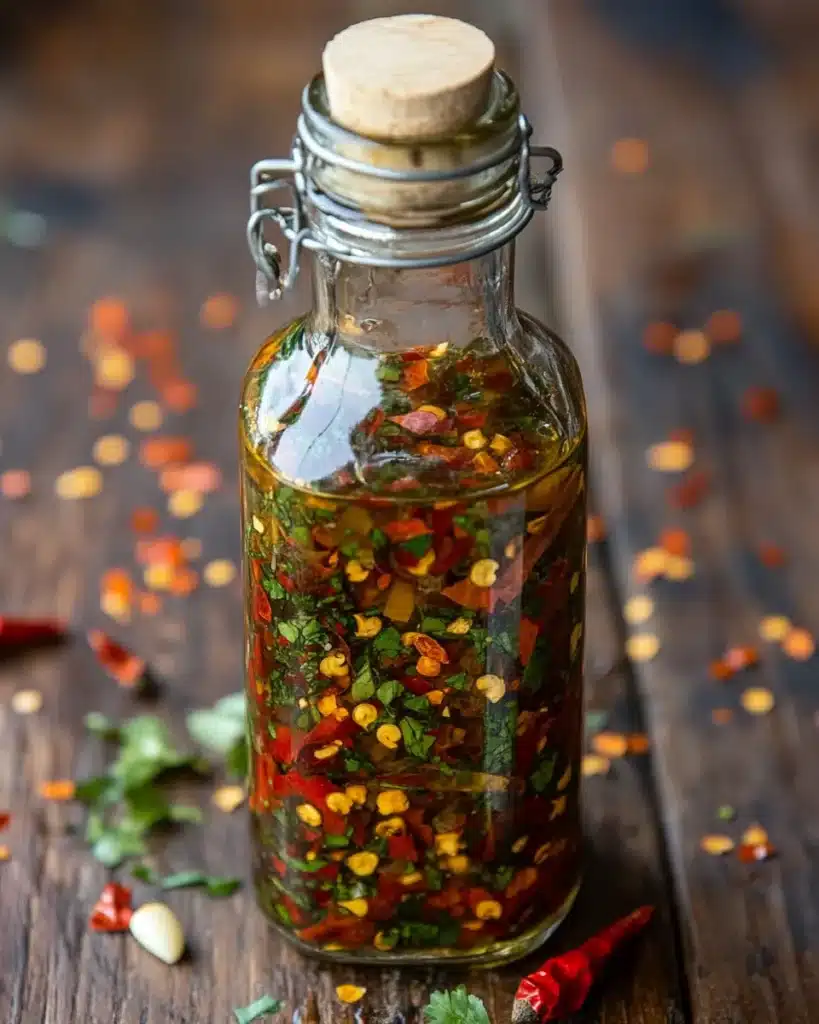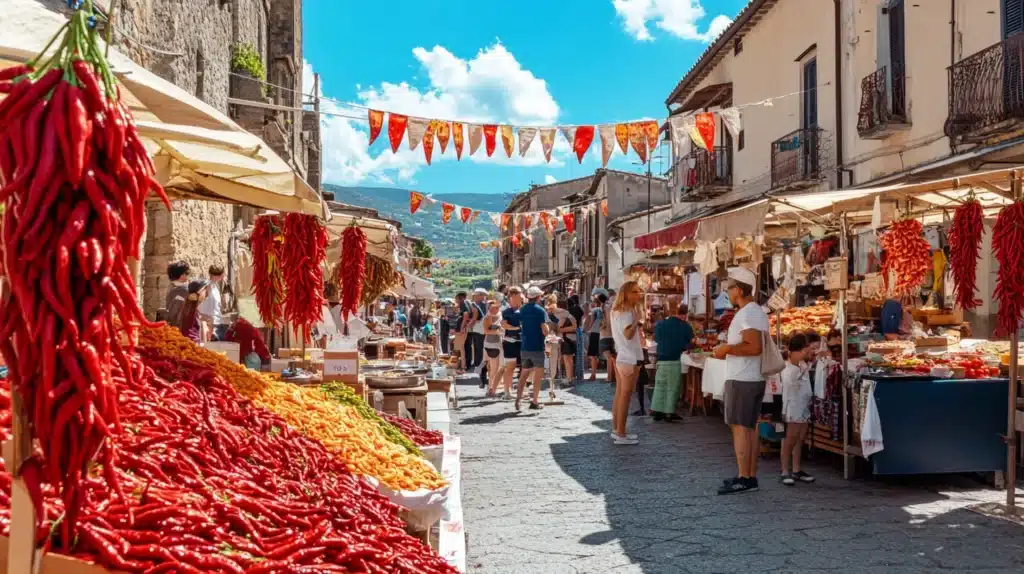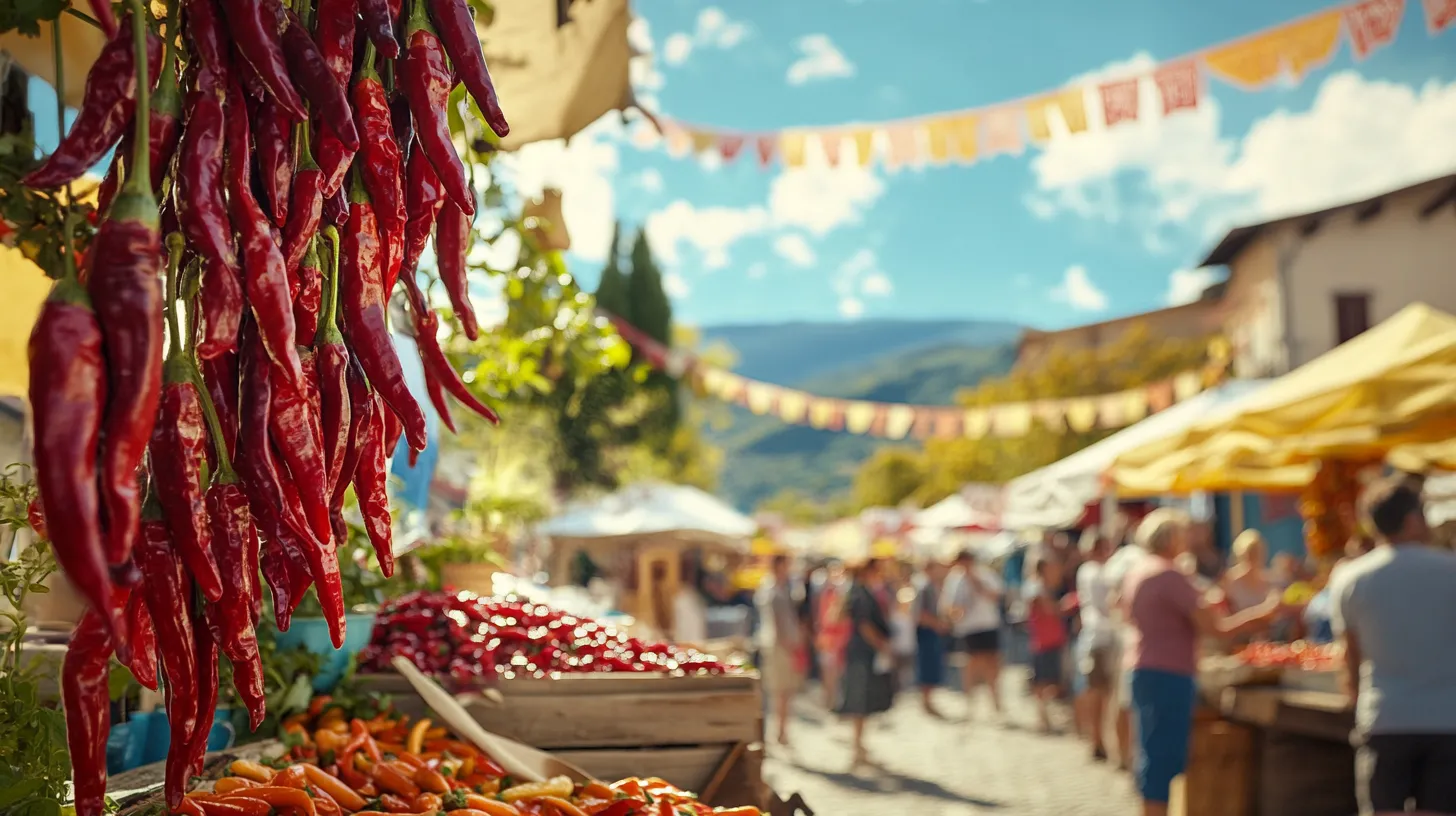Unveiling the Essence
Italian food is famous for its rich flavors and simple ingredients. One standout is the small but fiery peperoncino. This chili pepper adds a bold, spicy kick to dishes. It can transform even the most basic recipes into something unforgettable.
Unlike its mild cousin, pepperoncini, peperoncino is intense and versatile. You’ll find it in fresh, dried, or flaked forms. It’s a staple in Italian kitchens and beloved for its ability to elevate meals. Whether sprinkled on pizza or stirred into pasta, he always makes its presence known.
In southern Italy, especially Calabria, hot chili peppers is more than just an ingredient. It’s a cultural symbol. Festivals celebrate its heat, and families pass down recipes featuring this spicy star. In many ways, it represents the vibrant and bold spirit of Italian cooking.
This guide will explore everything you need to know about peperoncino. From its origins to its uses, and even tips on cooking with it. Let’s dive into the world of this fiery pepper and learn how it can transform your meals!
What is Peperoncino?
he is a type of chili pepper that adds bold heat to Italian dishes. Small, red, and fiery, it’s a must-have for spice lovers.
Popular Types
- Fresh : Fresh peppers provide a sharp, spicy bite. Cooks often use them in sauces, marinades, and as garnishes for cooked meals.
- Dried : These peppers have a long shelf life and are pantry essentials in Italian homes. Use them whole or crushed for pasta, soups, and sauces.
- Flakes: Perfect for sprinkling over pizza, pasta, or roasted vegetables, flakes are a quick and easy way to add heat. They are also common in Italian-American recipes to create authentic flavors.
Peperoncino vs. Pepperoncini
It’s easy to confuse peperoncino with pepperoncini, but they’re not the same. Pepperoncini are mild, pickled peppers used in salads or sandwiches. In contrast, peperoncino is spicy and adds bold flavor to dishes.
Key Differences:
- Heat Level: Peperoncino brings spice, while pepperoncini are mild and tangy.
- Usage: Peperoncino boosts dishes with heat; pepperoncini are eaten raw or pickled.
- Appearance: small and thin, while pepperoncini is larger and often wrinkled.
Regional Significance
In Italy, peperoncino is deeply tied to Calabria, a southern region known for its love of spicy flavors. Calabria’s warm climate and rich soil are perfect for growing chili peppers. Calabrian peperoncino is celebrated for its quality and intensity.
In Calabria, peperoncino is more than an ingredient; it’s a cultural symbol. Locals use it in pasta, infused oils, and spreads. The annual Festival in Diamante attracts thousands of visitors, celebrating this iconic spice with cooking shows, tastings, and competitions. This fiery event reflects Calabria’s passion for bold flavors and tradition.
Peperoncino in Italian Cuisine
Peperoncino is a key ingredient in Italian cooking. It adds bold heat and can transform simple dishes into flavorful creations. Its versatility and spice make it a favorite for chefs and home cooks alike.
Famous Dishes Featuring Peperoncino
Aglio, Olio e Peperoncino
This classic pasta dish shows the beauty of Italian simplicity. Garlic, olive oil, and peperoncino flakes come together to create a quick and satisfying meal. The chili balances the richness of the oil, giving the dish a perfect harmony of spice and flavor.

Peperoncino Pasta Variations
Beyond the classic dish, peperoncino shines in pasta recipes paired with seafood, tomatoes, or creamy sauces. These variations enhance the chili’s natural spiciness, adding new layers of taste to the meal.
Peperoncino on Pizza
Adding peperoncino flakes to pizza brings heat that complements toppings like mozzarella, pepperoni, and vegetables. This small addition can elevate your slice with an irresistible spicy kick.
More Ways to Use Peperoncino
Adding Depth to Sauces
Tomato-based and creamy sauces gain complexity with peperoncino. The spice enriches flavors and adds a unique touch to classic recipes like marinara or Alfredo.
Enhancing Meats
As a marinade or dry rub ingredient, this hot chili peppers boosts the taste of grilled meats, sausages, and chicken. It pairs smoky heat with savory flavors for a delightful result.
Perfecting Seafood Dishes
Seafood like spicy calamari or shrimp benefits from the vibrant heat of peperoncino. The chili enhances the delicate flavors of seafood without overwhelming them.
Peperoncino in Everyday Cooking
Boosting Simple Recipes
Even basic dishes like scrambled eggs or roasted vegetables can be elevated with a sprinkle of peperoncino. The spice brings vibrancy and turns simple meals into something memorable.
Infused Oils and Spreads
Infusing olive oil with peperoncino creates a flavorful base for cooking or drizzling over bread. Chili spreads can also be used as condiments for pasta, meats, or antipasti platters.

Substitutes for Peperoncino
When you don’t have peperoncino, these substitutes work well:
- Crushed Red Pepper Flakes: Easy to find and comparable in spice level.
- Calabrian Chili Paste: concentrated flavor with a smoky touch.
- Fresh Red Chilies: Thinly sliced, they provide a fresh and spicy taste.
Tips for Cooking with Peperoncino
Unlocking Flavor with Olive Oil
Toasting peperoncino in olive oil is a simple way to enhance its aroma and flavor. The heat releases the chili’s natural oils, creating a spicy base perfect for sauces, pasta, or marinades. Be sure to stir frequently to prevent burning.
Mastering the Right Balance
When adding peperoncino, start small and taste as you go. A little can add a gentle kick, while too much might overpower the dish. Adjust the spice level to suit your palate or the preferences of your guests.
Pairing for Perfection
To create balanced flavors, combine the chili’s heat with creamy ingredients like cheese or butter. Alternatively, use acidic elements like lemon juice or vinegar to cut through the spice and add a bright contrast. This approach works wonderfully in dishes like creamy pasta or spicy seafood.
Experimenting with Other Uses
Try using peperoncino in unconventional ways. Sprinkle it over roasted nuts for a spicy snack, or add it to chocolate desserts for a surprising twist. Its versatility allows it to enhance both savory and sweet recipes.
Whether sprinkled on pizza or stirred into sauces, peperoncino infuses dishes with heat and depth. It remains an essential ingredient in Italian cuisine, bringing boldness to every meal.
Cultural and Historical Context
The Origins of Peperoncino
The journey of peperoncino to becoming a beloved staple in Italian cuisine is deeply rooted in history. Interestingly, it was originally introduced to Europe from the Americas in the late 15th century. As a result, chili peppers quickly spread throughout southern Italy. In particular, farmers in regions like Calabria embraced the plant for its ability to thrive in their warm climate and its versatility in cooking. Over time, peperoncino naturally became a symbol of Italian ingenuity, transforming a foreign ingredient into a cornerstone of local cuisine.
Historical Role in Calabrian Cuisine
In Calabria, peperoncino is far more than just an ingredient; it is a way of life. Historically, it served multiple purposes in Calabrian households. It was used to preserve meats, such as in spicy sausages like nduja, and to flavor olive oils and bread. This fiery chili added spice and depth to simple, rustic dishes, reflecting the resourcefulness of the Calabrian people. Even today, peperoncino remains a defining feature of the region’s culinary identity.
Festivals and Traditions
Italians love to celebrate their food, and peperoncino is no exception. One of the most famous events, for instance, is the Peperoncino Festival in Diamante, Calabria. Thousands of visitors, as a result, come to this small town every year. They enjoy cooking shows, taste spicy dishes, and even join chili-eating contests. This festival, therefore, shows how important peperoncino is in Italian culture. Moreover, it brings people together to celebrate its heat, flavor, and history.

In addition to festivals, peperoncino has a place in Italian superstitions. Many believe it brings protection and good luck. This is why chili-shaped charms are common in Italian homes. The link between peperoncino and superstition shows its deep cultural ties in Italy.
Pro Tips for Cooking with Peperoncino
How to Avoid Overpowering Dishes with Spice
When cooking with peperoncino, it’s easy to go overboard. In reality, to avoid overwhelming your dish, start with a small amount and gradually add more as you taste. Remember, you can always increase the spice, but you can’t remove it.
For delicate recipes like seafood or creamy sauces, a light hand is essential. However, if you accidentally add too much, balance the heat with a creamy ingredient like cheese or yogurt. Additionally, adding a splash of lemon juice can tone down the spice effectively.
The Best Way to Store Fresh and Dried types
Proper storage is key to preserving the flavor and heat of peperoncino. First, fresh chilies should be kept in the refrigerator in a paper bag to allow airflow and prevent mold. Furthermore, use them within a week for the best taste. On the other hand, dried peperoncino can last much longer if stored in an airtight container away from direct sunlight.
To ensure its longevity, it’s important to keep it in a cool, dry place like a pantry.To extend its shelf life even further, consider freezing dried flakes or whole peppers. This method, as a result, locks in their aroma and spiciness for months.
Using Peperoncino to Elevate Simple Recipes
this is the secret to transforming basic dishes into memorable meals. For instance, add a pinch of chili flakes to scrambled eggs or roasted vegetables for a burst of heat. Moreover, drizzle olive oil infused with this hot chili peppers over fresh bread for an easy appetizer.
Even classic Italian recipes like aglio e olio or marinara sauce get a flavorful upgrade with the addition of this fiery spice. Finally, by toasting the peppery flavor in oil before adding it to your recipe, you unlock its full flavor potential. Consequently, every dish shines with bold and balanced heat.
Frequently Asked Questions (FAQs)
What is the difference between pepperoncini and peperoncino?
Pepperoncini and peperoncino are often confused; however, they are different. Pepperoncini are mild, pickled peppers often used in salads or sandwiches. Conversely, peperoncino is spicy and adds heat to dishes like pasta or pizza. While pepperoncini have a tangy, vinegary taste, peperoncino provides a fiery kick that enhances the overall flavor of a dish.
Is crushed red pepper the same as peperoncino?
Crushed red pepper is similar to, but not exactly the same. Crushed red pepper often includes a mix of different dried chilies, making its flavor less distinct. however, is usually made from specific Italian chilies, which gives it a unique taste. If you want authentic Italian heat, he is the better choice.
What is a substitute for peperoncino in recipes?
If you don’t have the piquant flavor of pepper, you can use crushed red pepper flakes. Fresh red chilies or Calabrian chili paste are also excellent substitutes. These options bring a similar level of heat and flavor to your dishes. Alternatively, smoked paprika can add a hint of spice and depth for certain recipes.
Can I use banana peppers instead of peperoncino?
Banana peppers are much milder than peperoncino. While you can use them for a similar texture, they won’t provide the same spicy kick. For heat, consider adding a small amount of crushed red pepper along with banana peppers. This way, you get the desired spice without changing the texture.
Is Calabrese peperoncino the same as Calabrian chili?
Yes, Calabrese peperoncino is the same as Calabrian chili. In fact, both terms refer to the spicy chilies grown in Calabria, Italy. These chilies are not only famous for their heat but also for their bold flavor, making them a staple in Italian cooking. Moreover, they are often used in nduja (a spicy spreadable sausage) and in various pasta sauces to enhance the dishes with a fiery kick.
Conclusion
Peperoncino is more than just a chili; it is a symbol of Italy’s vibrant food culture and rich history. From festivals in Calabria to its everyday use in kitchens, it represents the bold flavors that make Italian cuisine so loved around the world. Its spicy heat brings flavor and excitement to many dishes, from pasta to pizza and beyond.
Now is the perfect time to try italian chili in your own cooking. Experiment with it in simple recipes, or use it to add a twist to your favorite meals. Whether you prefer it fresh, dried, or as flakes, the peppery flavoris sure to elevate your dishes. Finally, don’t forget to share your favorite recipes or ideas for using this hot chili peppers in the comments below. We’d love to hear your culinary creations!
